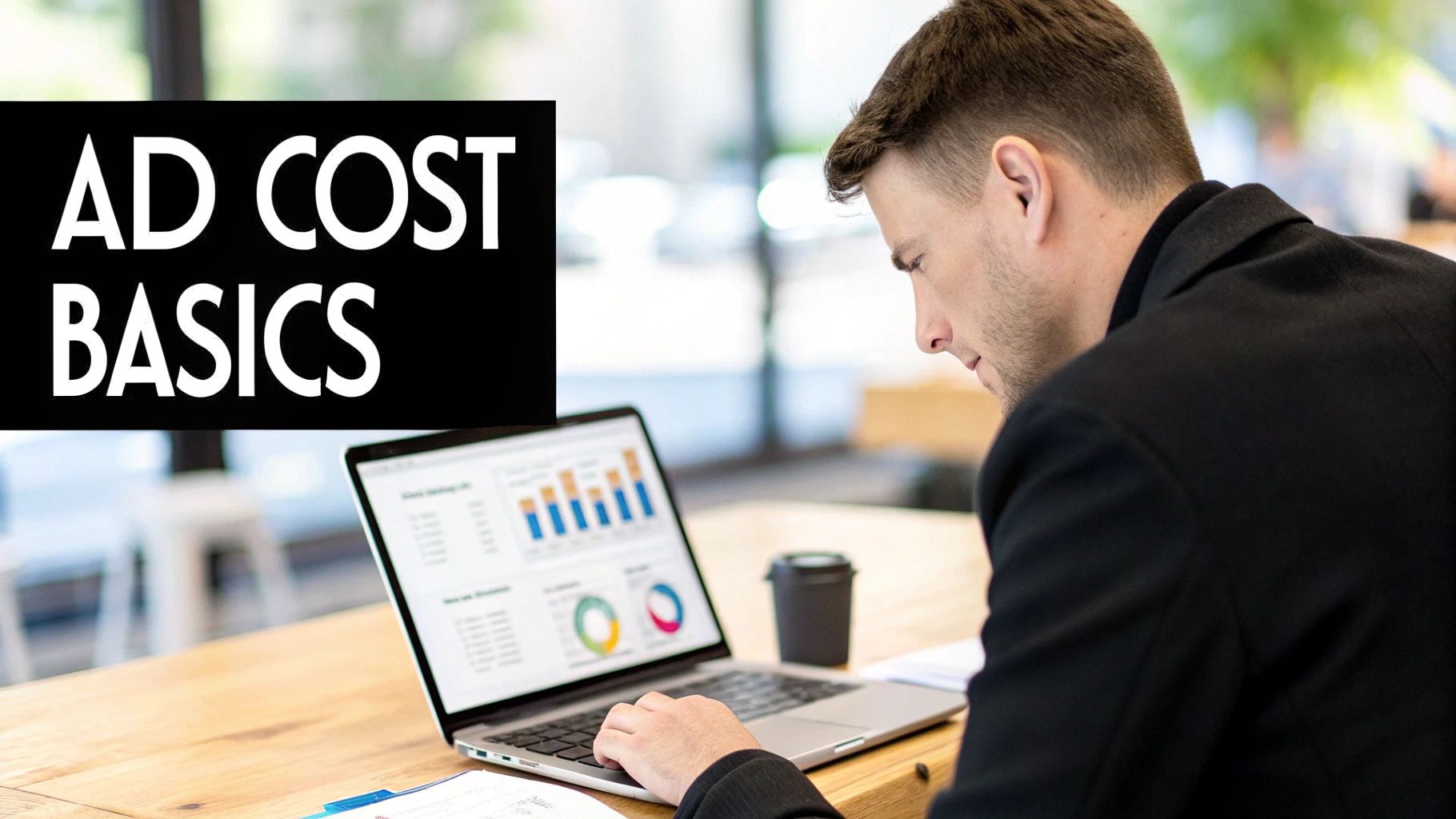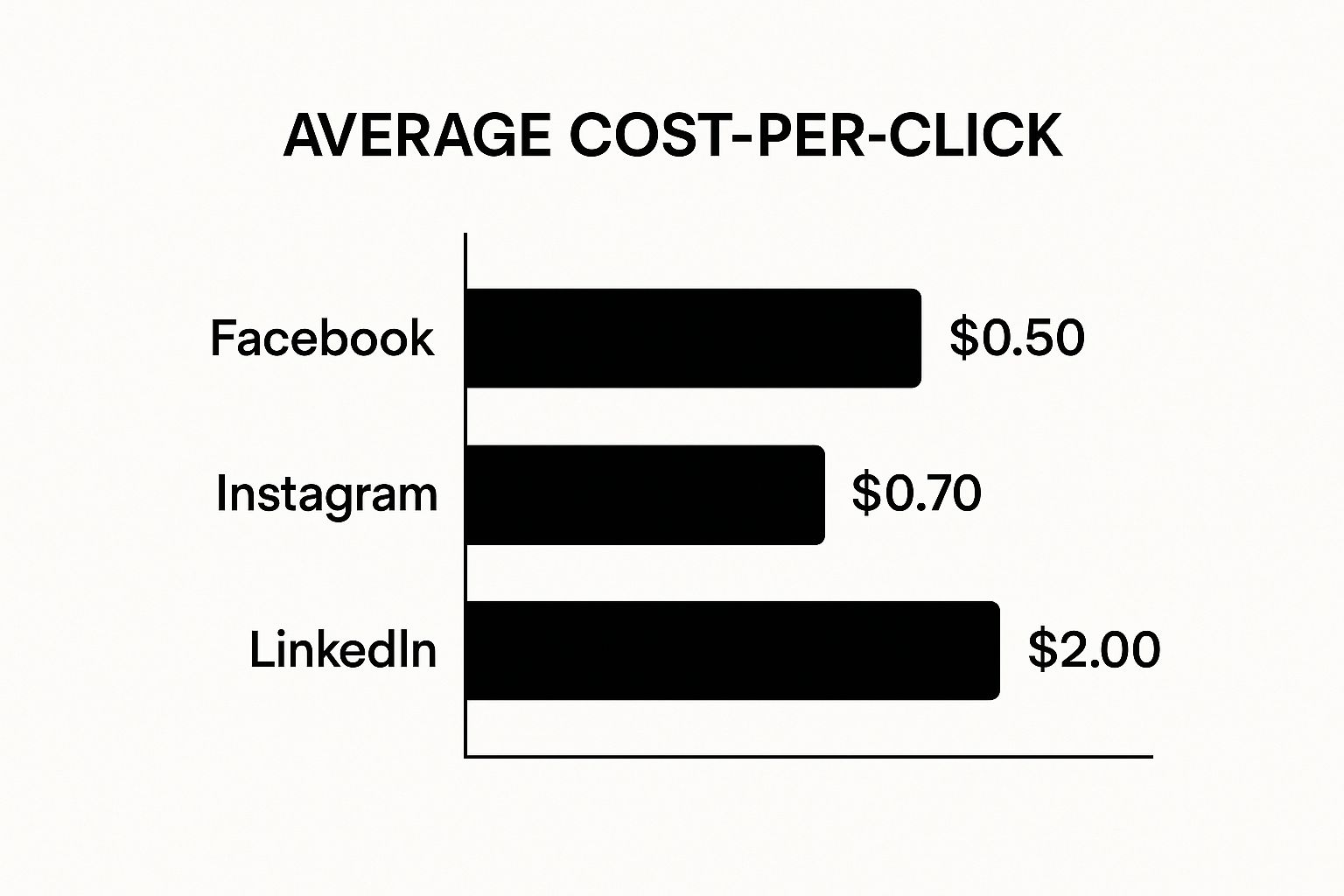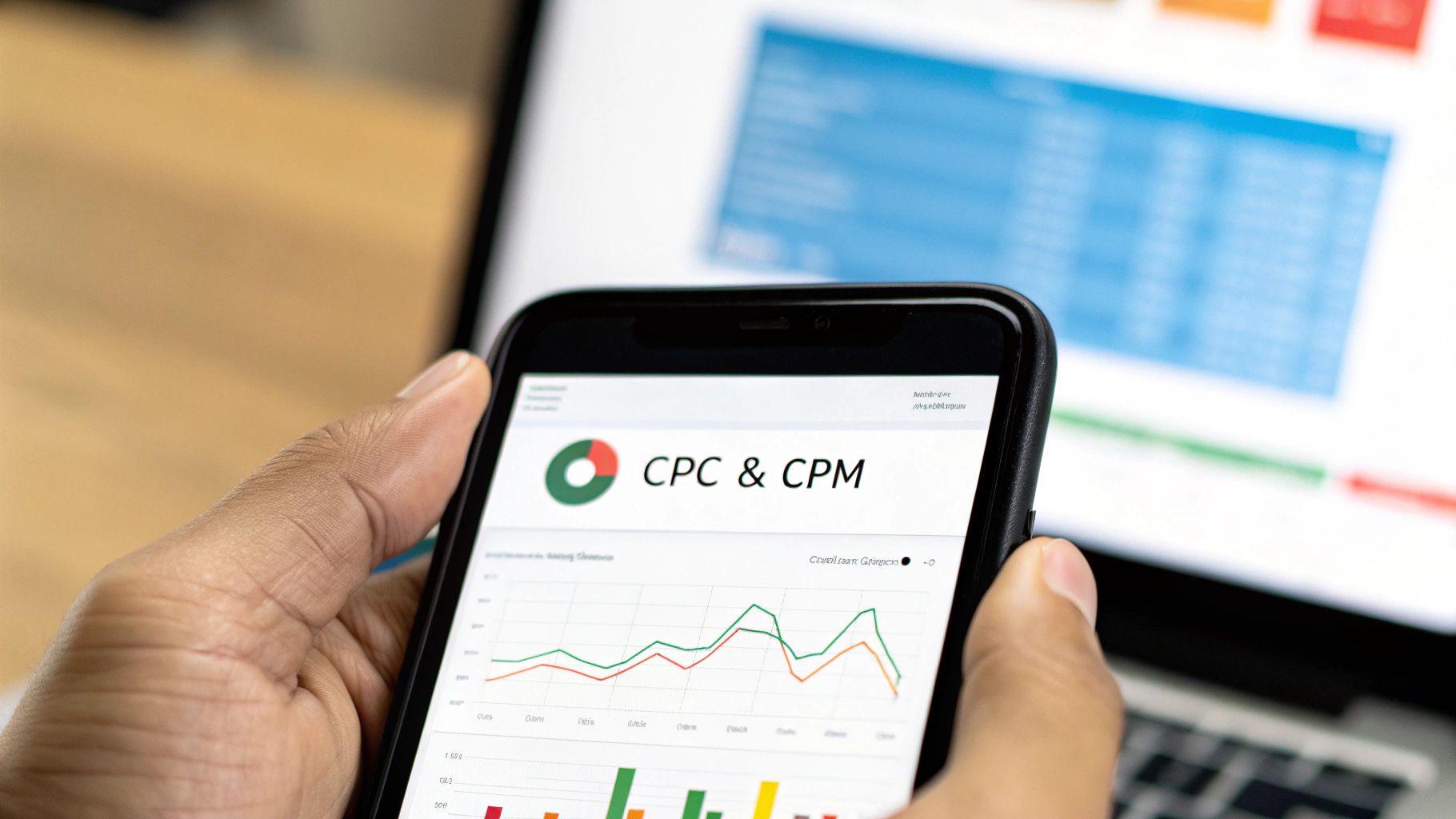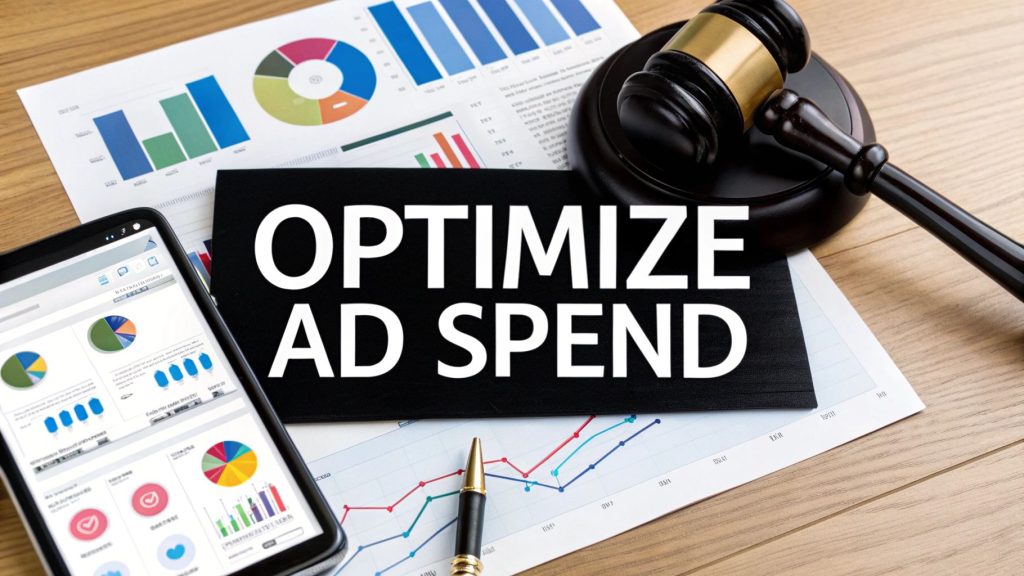Making Sense of Social Media Advertising Costs

Imagine social media ad costs as a bustling digital auction. Millions of businesses are vying for your potential customer's attention. Every time someone scrolls, a lightning-fast auction takes place behind the scenes, determining which ads get displayed. Understanding these costs isn't about memorizing a price list. It's about grasping the dynamics of this auction.
Your success depends on understanding how platform algorithms weigh different factors: your bid, the relevance of your ad to the audience, and the quality of your content. For example, a highly relevant ad with engaging content might win the auction even if your bid is lower than a competitor's less relevant ad.
Decoding the Auction Dynamics
Several factors influence social media advertising costs. Your bid, of course, is a key player. But it’s not the only one. Platforms like Facebook and Instagram also consider your ad quality and targeting.
A high-quality ad – measured by things like engagement and click-through rates – can actually lower your costs. Think of it like a well-tuned engine: it gets you further on less fuel. Highly specific targeting, on the other hand, can sometimes increase your bid price due to higher competition within that niche. It’s similar to real estate: a desirable property (your target audience) commands a higher price.
Seasonal trends also play a role. Just as airfares spike during holidays, ad costs tend to rise during peak shopping seasons. Understanding these predictable cycles helps you plan your campaigns and budget strategically. Anticipating these trends allows you to allocate your budget effectively, maximizing your return during these crucial periods.
The Regional Landscape and Market Growth
Let's take a look at the regional advertising landscape. The MENA (Middle East and North Africa) region, for instance, is experiencing significant growth. By 2024, the social media advertising market in MENA is projected to reach $12.3 billion. This growth reflects a global trend of increasing investment in digital and social media advertising to connect with a growing online audience.
To understand these regional dynamics in more detail, let’s look at the table below:
Global Social Media Advertising Market Growth
Regional advertising spend growth projections and market size comparisons
| Region | Market Size (Projected 2024) | Growth Rate | Key Drivers |
|---|---|---|---|
| MENA | $12.3 Billion | (Data not provided in original text) | Increasing internet penetration, rising disposable incomes, growing young population |
| North America | (Data not provided in original text) | (Data not provided in original text) | High social media usage, mature digital advertising market, strong economic growth |
| Europe | (Data not provided in original text) | (Data not provided in original text) | Growing e-commerce market, increasing mobile advertising spending, data privacy regulations |
| Asia Pacific | (Data not provided in original text) | (Data not provided in original text) | Large population base, rapid mobile adoption, emerging digital economies |
This table illustrates how different regions contribute to the global social media advertising market and the forces shaping their growth. While the original text focused on MENA, a global perspective helps illustrate the wider context. Notice how factors like internet penetration and mobile adoption are key drivers across various regions.
For more specific insights into regional advertising trends, you can explore resources like Statista.
Competitive Landscape and Your Wallet
Your competitors’ actions directly affect your advertising costs. If they're aggressively bidding on the same keywords or targeting the same audience as you, it pushes the price up for everyone. It's like a bidding war at an auction – the highest bidder wins, but everyone ends up paying more.
Conversely, if your competitors are less active, you might be able to secure lower costs. This highlights the importance of consistently monitoring the competitive landscape and adapting your strategies. Knowing what your competitors are doing is essential for making informed decisions.
Understanding these factors empowers you to make smart choices about your social media advertising budget and maximize your return on investment. It's not just about spending money; it's about spending it effectively. In the next section, we’ll delve into how different platforms price their ads, unveiling the specific nuances of each social media marketplace.
How Each Platform Prices Your Ads Differently
Think of each social media platform as its own bustling marketplace. Facebook and Instagram, with their massive reach and detailed targeting options, are like vibrant city centers – predictable, but you'll pay a premium for the location. LinkedIn, on the other hand, is more like an exclusive industry conference. The cost of entry is higher, but the potential connections you make are far more valuable. And then there's TikTok, the up-and-coming neighborhood that's rapidly growing in popularity (and price).
Each platform's ad auction system mirrors its unique environment. Facebook's granular targeting creates competition, which drives up prices but also leads to better conversion rates. Instagram, with its visual focus, rewards eye-catching creative, resulting in improved reach. LinkedIn's professional setting justifies its higher cost through the quality of B2B leads it delivers. This is why you might see different costs across platforms, even when targeting similar demographics.
Deciphering the Cost Models: CPC, CPM, and CPA
Navigating social media ad costs requires understanding the different pricing models. The three main ones you'll encounter are cost-per-click (CPC), cost-per-mille (CPM) (cost per 1,000 impressions), and cost-per-acquisition (CPA).
Imagine you're running a brick-and-mortar store. CPC is like paying for each person who walks through your door. CPM is like paying for a billboard seen by thousands of passersby. CPA is like only paying when someone actually makes a purchase. Each model serves different goals. If you're building brand awareness, CPM might be the most economical. But if your goal is driving sales, a CPA model offers a more direct return. You might be interested in how much to pay influencers for similar objectives.
Comparing Costs Across Platforms
The actual costs can fluctuate significantly. Take a look at this infographic comparing the average cost-per-click across Facebook, Instagram, and LinkedIn.

As the data shows, LinkedIn's CPC is considerably higher than Facebook or Instagram, reflecting its focus on professional networking and B2B interactions. While Facebook and Instagram offer more budget-friendly CPCs, the right platform depends on your target audience and marketing goals. For businesses prioritizing a strong visual presence, our guide on Instagram Advertising could be helpful.
To give you a more complete picture, let's look at a table comparing these platforms across different pricing models.
To help you understand the typical costs across different platforms and pricing models, I've put together this comparison table.
Platform Pricing Model Comparison
Detailed breakdown of CPC, CPM, and CPA rates across major social media platforms
| Platform | Avg CPC | Avg CPM | Avg CPA | Best For |
|---|---|---|---|---|
| $0.97 | $7.19 | $18.58 | Brand awareness, lead generation, app installs | |
| $3.56 | $7.91 | $44.86 | Brand building, visual storytelling, influencer marketing | |
| $5.26 | $6.59 | $135.97 | B2B lead generation, professional networking | |
| TikTok | $1.00 | $10.00 | $50.00 | Reaching younger audiences, viral marketing |
Note: These are average figures and can vary based on industry, targeting, and ad quality.
As you can see, the costs vary significantly depending on the platform and the pricing model. While these numbers offer a good starting point, remember that several factors influence actual social media ad costs:
- Your Industry
- Target Audience
- Campaign Objectives
- Ad Quality
Understanding these variables, and how they interact on each platform, is crucial for allocating your budget effectively and hitting your marketing targets. The platform you choose should align with your audience and your overall marketing strategy.
The Invisible Forces That Control Your Ad Costs

Social media advertising costs can be tricky. It's not just about setting your budget and picking your audience. There are other factors, "invisible forces" constantly at work behind the scenes. Think of it like ocean currents subtly affecting your ad's journey.
Ad Quality: Your Secret Discount Weapon
Your ad quality score works a bit like a discount program. Platforms like Facebook and Instagram reward ads that are engaging and relevant by charging less for them. It's similar to a frequent flyer program – the better your ads perform, the less you'll pay down the line. On the other hand, if people ignore your ads because they're low quality, you'll likely end up spending more. A well-designed ad with a captivating image and sharp text will usually outperform a generic one with a blurry picture and irrelevant text.
Imagine two ads for coffee shops. One has a vibrant photo of a latte with enticing copy. The other uses a generic stock image and dull text. Which one are you more likely to click?
Audience Saturation: The Supply and Demand Game
Audience saturation is a lot like real estate. Popular audiences are more expensive because lots of advertisers want to reach them – high demand, high cost. Less competitive audiences, often niche groups, are often much more affordable. Targeting a wide demographic, like "adults 25-54," can be pricier than focusing on a specific interest, like "craft beer enthusiasts." Finding those niche audiences can be a game-changer for your budget.
Seasonal Fluctuations: Riding the Cost Waves
Think of seasonal trends as predictable "cost waves." Holidays, back-to-school, and even specific industry busy periods increase competition, which drives up costs. Savvy advertisers anticipate these trends and adjust their budgets and strategies accordingly. Launching a winter clothing campaign in summer might result in lower initial costs and let you build momentum before the peak season.
Campaign History: Building a Good Reputation
Your past campaign performance contributes to a reputation that affects future pricing. Platforms reward consistency. It's like having a good credit score. If your track record shows engaging, relevant ads, platforms are more likely to give you better ad placements at a lower cost.
Location, Location, Location: Geographic Cost Disparities
Where you target your ads geographically matters a great deal. Big cities usually have higher ad prices due to higher competition and more consumer spending. Smaller markets often offer lower costs and unique opportunities. Knowing these geographic differences can save you money, especially if your business operates in multiple areas. This means understanding the specific social media environment of each region. For example, the social media analytics market in the Middle East and Africa (MEA) region generated $1,088.4 million in revenue by 2024 and is projected for significant growth. You can learn more about social media analytics trends in the MEA region through this research.
Other Influencing Factors
Many other things influence ad costs. The devices you target (mobile vs. desktop), the specific times you choose to run your ads (dayparting), and even your industry can all play a role in the final price. Understanding these "invisible forces" helps you become a more effective social media advertiser, making the most of your budget and getting better results.
Why Location Matters More Than You Think

Ever notice how the price of, say, a cup of coffee can change drastically depending on where you are? The same principle applies to social media advertising. Costs fluctuate based on location, presenting both hurdles and advantages. Imagine the difference in price between a small apartment in a rural town and a penthouse in a bustling metropolis. That's similar to how social media ad costs vary geographically, a vital consideration for businesses in the AE region or targeting a global audience.
Developed Vs. Emerging Markets: Finding The Sweet Spot
In developed markets like North America and Western Europe, expect higher social media advertising costs. Think of it as the price of admission to a highly competitive, affluent marketplace. While the cost is high, you often get what you pay for: advanced targeting options and robust analytics. This can lead to higher conversion rates, making the investment worthwhile.
Emerging markets, however, offer a different landscape. Lower costs often go hand-in-hand with a rapidly expanding digital audience. It's like discovering a hidden gem with untapped potential. For businesses looking to broaden their reach, these markets represent a compelling opportunity. The Middle East and North Africa (MENA) region is a prime example of this dynamic, with a burgeoning digital scene and comparatively lower ad costs.
The MENA Region: An Expanding Horizon
The MENA region's digital advertising scene, particularly on social media, is booming. Video ad spending, for instance, is projected to reach $2.8 billion by 2025, a dramatic leap from $1.1 billion in 2020. Discover more insights into MENA's digital ad market. This growth signals significant opportunity. Smart advertisers can harness these lower costs and expanding audiences to gain a real competitive edge.
Currency Fluctuations: The Unseen Variable
When running international campaigns, currency fluctuations can significantly impact your budget. Let's say you set your budget in US dollars, but your target audience is in the UAE. Shifts in the exchange rate can unexpectedly inflate or deflate your actual spending in local currency, affecting your overall return. Careful monitoring and adaptable planning are essential to manage these currency dynamics and maintain budget control.
Cultural Nuances: Beyond Words
Culture impacts more than just language; it affects consumer behavior and, consequently, advertising costs. Platforms favored in certain regions see increased demand, driving up prices. Think about the varying popularity of different social media platforms around the globe. Local holidays, cultural events, and economic trends also create predictable cost fluctuations. Advertisers who understand these patterns can strategically time their campaigns, maximizing their budget during less competitive periods. Even language targeting itself plays a role. Some languages, due to lower competition or higher commercial intent, command higher advertising rates. By grasping these cultural subtleties, advertisers can fine-tune their targeting and messaging, ensuring campaigns connect with their intended audience and optimize social media advertising costs.
Smart Budgeting That Actually Works
Planning your social media advertising budget is a lot like planning a road trip. You wouldn't just hop in the car and start driving, would you? You'd map out your route, estimate fuel costs, and maybe even set aside some money for unexpected detours. Smart social media advertisers do the same. They identify their goals, set realistic timelines, and build in flexibility to handle changes in ad costs. Savvy marketers also diversify their spending, allocating budget to proven winners, promising contenders, and entirely new approaches.
The 70-20-10 Rule: A Balanced Approach
Imagine you're managing a portfolio of investments. You wouldn't put all your eggs in one basket, right? The 70-20-10 rule offers a similar balanced approach to social media ad budgeting.
- 70% goes to your reliable workhorses – the campaigns with a proven track record of delivering a solid ROI. This is your foundation.
- 20% is allocated to campaigns that show promise but need a little extra boost. Think of this as nurturing your rising stars. This allows you to scale successful strategies and further optimize promising campaigns.
- 10% is reserved for bold experimentation – testing new platforms, audiences, or ad formats. This is where you can take calculated risks and potentially discover the next big winner.
This diversified approach allows you to capitalize on what's already working while leaving room for growth and discovery.
Understanding the Platform Learning Phase
Ever notice how a new employee takes a bit of time to get up to speed? Social media platforms are similar. Their algorithms need time and data to learn how to best optimize your campaigns. This initial period is often called the learning phase.
During this phase, your ad costs might seem a bit higher than expected. Don't panic! It's like investing in training for your team. The platform is gathering data to understand your target audience and refine its delivery. Patience and proper budget allocation during this phase are key to long-term success.
Seasonal Planning: Anticipating the Peaks and Valleys
Think about how prices for certain goods and services fluctuate throughout the year. Social media ad costs behave similarly, often influenced by seasonal trends. Major holidays, back-to-school periods, and even industry-specific events can impact ad pricing.
For instance, during Ramadan in the UAE, competition for ad space increases, which can drive up costs. Anticipating these seasonal peaks and valleys allows you to adjust your bids and budget strategically, ensuring your campaigns remain effective without breaking the bank. Planning ahead is crucial, just like booking flights and accommodations in advance for peak travel seasons. You might also find helpful insights about overall business growth strategies.
Advanced Budgeting Techniques for Maximum Impact
Sophisticated budgeting goes beyond just setting a total spend. It's about strategically allocating resources where they'll have the greatest impact. Think of it like a seasoned chef adjusting ingredients to perfect a recipe. Here are a few advanced techniques:
- Dayparting: This involves concentrating your ad spend during specific hours when your target audience is most active online. It's like setting up shop at the busiest times in the market.
- Geographic Budget Allocation: If your ads perform exceptionally well in a particular region, like Dubai, you can allocate a larger portion of your budget to that area. It's about focusing your efforts where they yield the highest returns.
- Dynamic Budget Adjustments: This allows you to respond to real-time data. If a campaign is taking off, you can automatically increase its budget to maximize results. Conversely, you can scale back or pause underperforming campaigns to avoid wasting precious resources.
These advanced techniques provide greater control and flexibility, allowing you to optimize your ad spend for maximum efficiency.
Building a Sustainable Budget
A sustainable budget isn't just about staying within your limits; it's about achieving long-term profitability. Here are a few essential considerations:
- Maximum Sustainable CPA: Your cost-per-acquisition (CPA) is the amount you're willing to spend to acquire a new customer. Knowing your maximum sustainable CPA helps you determine the right bid for your campaigns.
- Realistic Testing Budgets: Testing is essential for optimizing your campaigns, but you need sufficient budget to get statistically significant results. This allows you to confidently evaluate different strategies and make informed decisions.
- Scaling Strategies: As your campaigns grow, you need a plan to scale your budget efficiently. This often involves gradually increasing spend while carefully monitoring performance to maintain a positive ROI.
To understand how to distribute your budget across different campaign types, let’s take a look at the following table:
Budget Allocation Framework: Strategic budget distribution across campaign types and optimization phases
| Campaign Type | Budget % | Purpose | Success Metrics |
|---|---|---|---|
| Brand Awareness | 20% | Increase brand visibility and reach | Impressions, Reach, Brand Lift |
| Engagement | 20% | Drive interactions and build community | Likes, Comments, Shares, Video Views |
| Lead Generation | 30% | Capture leads and nurture prospects | Lead Form Submissions, Cost Per Lead |
| Conversions (Sales) | 30% | Drive sales and other conversions | Conversions, Cost Per Acquisition, Return on Ad Spend |
This framework provides a starting point for allocating your budget based on your campaign objectives. Remember that these percentages can be adjusted based on your specific business needs and performance data.
By mastering these budgeting techniques, you can transform your social media advertising spend into a powerful and predictable engine for business growth.
Measuring What Actually Matters
Return on investment (ROI) in social media advertising isn't just about crunching sales numbers. It's about understanding the full customer journey, like tracing a river from its many tributaries down to the sea. Each touchpoint – from the first ad impression to the final purchase – plays a role in achieving your business goals.
Beyond Immediate Returns: A Holistic View of ROI
Direct ROI captures immediate sales, the clearest and most obvious result of your efforts. But smart advertisers look beyond the surface. They measure things like how much brand awareness grows, how customer lifetime value improves, and how different platforms work together. Think about it: a customer might see your ad on Facebook, then later search for you on Google, and finally buy something from your website. If you only credit Google Search, you’re missing the initial spark that Facebook provided.
Building a Robust Tracking System: Foundations for Success
Accurate tracking is your bedrock. You need to capture both online and offline conversions. Attribution windows are key. These are the timeframes you set to connect an ad interaction with a conversion. If your typical customer takes weeks to research before buying, your attribution window should reflect that longer decision-making process. Someone buying a candy bar on impulse? Much shorter window.
Think about return on ad spend (ROAS), too. This tells you how much revenue you earn for every dirham spent on ads. It gives you a much sharper picture of campaign performance than simply looking at overall costs. Tools like marketing campaign tracking can further fine-tune your setup.
Advanced Measurement Techniques: Unveiling Hidden Insights
Want to go deeper? Advanced techniques offer even more granular data. Incrementality testing helps you isolate the impact of your advertising from organic growth. It’s like a science experiment: one group sees your ads, the control group doesn’t. This tells you how much growth you can directly link to your ads.
Cohort analysis helps understand long-term customer value. You group customers who share something in common (like when they first bought something from you) and track them over time. This helps you spot which customer groups are your most valuable players in the long run.
Finally, multi-touch attribution models give credit where credit is due across complex customer journeys. Instead of giving all the credit to the last click, these models assign weighted values to each touchpoint along the way. This gives you a more realistic view of how your different marketing activities work together to create conversions. When planning your budget, knowing how to effectively allocate ad spend across channels is crucial.
Data Visualization and Actionable Insights: Communicating Value
The final piece of the puzzle? Presenting your ROI data in a way that’s clear, compelling, and justifies your advertising investment. Think dashboards and reports that bring your campaign impact to life. For instance, a screenshot from Google Analytics can show how different channels contribute to website traffic and conversions.
This visual data helps you quickly see which channels are driving the most valuable traffic. Maybe organic search brings in the most users, but social media has a higher conversion rate – meaning it's better at actually driving sales.
By digging into this data, you can pinpoint which campaigns deserve a bigger budget, which need tweaking, and which should be scrapped altogether. This creates a constant feedback loop, always improving your advertising efficiency and making a real impact on your bottom line.
Your Next Steps to Smarter Ad Spending
Successfully managing your social media ad costs isn't a one-time fix; it's about creating a system that consistently delivers. Think of it like tuning a piano – regular adjustments keep it sounding its best. We need to turn the insights we've discussed into a clear action plan.
Audit, Test, and Monitor: Your Action Plan for Success
First, take a close look at your current campaigns. Think of it as a health check-up. Use the benchmarks we've covered to find quick wins – those small adjustments that can quickly improve your cost efficiency. Are you reaching the right people on the right platform? Is your ad creative as engaging as it could be?
Next, set up a regular testing schedule. This is how you continually refine your approach. Think of it like trying out different recipes to find your new favorite dish. Test different ad creatives, audience segments, bidding strategies, and even platforms. See what connects best with your audience. Tracking and analyzing your campaign performance is key to maximizing your ROI. For a deeper dive into important metrics, check out this article on campaign performance metrics.
Finally, create reliable monitoring systems to catch any cost fluctuations before they impact your budget. It's like having a smoke detector – early warnings can prevent major problems. Set up alerts for things like sudden CPC spikes or drops in conversion rates. Having a plan helps you react quickly and effectively.
Building a Cycle of Continuous Improvement
Just like regular car maintenance prevents breakdowns, your action plan should include regular reviews:
-
Quarterly Budget Reviews: Make sure your spending aligns with your overall business goals. Are your ads contributing to your bottom line? Do you need to adjust your budget based on market changes?
-
Monthly Optimization Cycles: Stay on top of platform updates and seasonal trends. Social media platforms are always changing. Regular optimization keeps your strategies fresh and effective.
-
Weekly Monitoring: Catch potential issues early on. Regular check-ins allow you to address small problems before they become big ones.
Practical Tools and Resources for Success
To help you on your journey, we offer practical tools and resources, including:
-
Templates for Tracking Key Metrics: Stay organized and focused on the data that truly matters. Having the right metrics readily available simplifies decision-making.
-
Optimization Checklists: Make sure you’re covering all the essentials and not missing any crucial steps. A checklist keeps you on track.
-
Decision-Making Frameworks for Budget Allocation: Make informed choices about where to invest your ad budget. A clear framework helps prioritize your spending for maximum impact.
The goal is to turn social media advertising from a variable expense into a predictable and scalable growth engine. This means achieving consistent returns while adapting to the ever-changing digital landscape.
Ready to make your social media advertising a predictable growth engine? Explore how Technogital F.Z.C can help you achieve measurable results. Visit us today to learn more.

